▶ Watch Video: The Betrayal of Linda Slaten
On Sept. 4, 1981, Jeff Slaten, 15 and his brother Time, 12, were awakened by Lakeland, Florida, police and told their mother, Linda Slaten, had been murdered. Investigators collected a rape kit and lifted a palm print from the windowsill where the killer had entered. They questioned a slew of suspects, but no one was charged, and the case went cold.
Prior to and after Linda Slaten’s murder, Tim’s football coach, Joe Mills, would regularly drive Tim to and from football practice. Coach Joe became a role model for the young boy, who proudly hung up his football team photo in his room where Mills stood right behind him.
Linda’s sons spent decades living in fear of the man they called “the Monster.” Nearly 40 years later, advances in DNA technology revealed Linda Slaten’s likely killer: Coach Joe.
“I looked up to this guy,” Tim tells “48 Hours” contributor Jim Axelrod. “And I had a picture in my house ever since then, and never knew it was him.”
“He’s a cold-hearted monster, that’s for sure,” says Jeff.
SEPTEMBER 4, 1981
Jim Axelrod: On the morning of September 4th, 1981 … you’re going to walk three doors down —
Judy Butler: Mm-hmm.
Jim Axelrod: — and have a cup of coffee with your sister.
Judy Butler: Right.
When Judy Butler knocked on her older sister’s front door, Linda Slaten never answered. At the time, the sisters both lived in a Lakeland apartment complex.
Jim Axelrod: So, you started to walk back to your place, and what happened?
Judy Butler: And I turn, and I see that the screen is out of the window.
Linda’s bedroom window was wide open. Judy walked over and looked inside.
Judy Butler: And my vision comes across her.
Jim Axelrod: Where was she?
Judy Butler: She was laying … instead of up and down on the bed, she was laying crossways. … And at first, I thought maybe she was asleep. … And then, then, I just started screaming.
 Linda Slaten’s killer entered through her bedroom window.
Linda Slaten’s killer entered through her bedroom window.
Lakeland Police Department
When police arrived, they found the partially nude body of Linda Slaten, 31, with a wire coat hanger wrapped around her neck. The killer had entered her bedroom through the open window.
The crackle of police radios inside the small two-bedroom apartment woke up Linda’s 15-year-old son, Jeff, who was sleeping on a cot in the living room.
Jeff Slaten: I asked, “What is goin’ on?” He said, “Police officers. … Put on some clothes and go outside.” And he made sure I went out the front door.”
Jeff Slaten: And when I went out there, it looked like every cop in the state of Florida … news crews, and my Aunt Judy was out there crying, and she told me my mom been murdered (cries). And I just couldn’t believe it.
In the apartment’s second bedroom, another officer woke up Linda’s younger son, Tim, then 12 years old.
Tim Slaten: He goes, “You need to wake up and go outside with your brother.” He never mentioned my mom. I’m like, “why’s he not saying my mom? And why’s a cop waking me up?”
Still in his pajamas, Tim walked past his mother’s closed bedroom door. Suddenly, it swung open, as an officer left the room.
Tim Slaten: And I saw the whole crime scene. … I mean, I saw my mom’s bloody body with a coat hanger around her neck (cries).
Jim Axelrod: You can’t unsee that.
Tim Slaten (very emotional): No. … And I still see it.
1974 | SEVEN YEARS BEFORE THE MURDER
 Linda Slaten, 31,was raped and strangled with a wire coat hanger as her two sons Jeff, 15, and Tim, 12, slept in their Lakeland, Florida, apartment.
Linda Slaten, 31,was raped and strangled with a wire coat hanger as her two sons Jeff, 15, and Tim, 12, slept in their Lakeland, Florida, apartment.
Jeff Slaten
In 1974, Linda Slaten was a 24-year-old single mom — finally free. She had just divorced Jeff and Tim’s abusive father, Frank Slaten, after nine volatile years of marriage.
Jeff Slaten: He was a violent alcoholic to be honest with you.
Tim Slaten: Yes.
Jim Axelrod: Did he hit your mom?
Jeff Slaten: Oh, yeah.
Tim Slaten: Yes.
In the years that followed, nothing was easy for the young family. Linda struggled for work, made her own clothes to save money, and couldn’t afford a car.
Jim Axelrod: If you couldn’t get a ride to practice, who would take you?
Tim Slaten: Coach come pick us up.
That’s “Coach Joe,” as the kids called him. He often drove Tim and some other boys to and from football practice.
SEPTEMBER 3, 1981 | LINDA SLATEN’S FINAL HOURS
On the last full day of her life, Linda and Jeff argued. Tensions had been rising with her teenage son.
Jeff Slaten: I remember coming home, there was nothing to eat in the house. … You know how it is when you’re a 15, 16-year-old kid, you’re mouthy and …
Jeff Slaten: I got mad, and I went out the door and got on my bicycle and road 11 or 12 miles to the northside of town … to go to my grandma and grandpa’s house to get somethin’ to eat.
At 8:30 that night, Tim came home from football practice.
Tim Slaten: The coach brought me home.
Around 9 p.m., Linda took Tim to a party next door to play cards.
Jeff Slaten: Grandma and grandpa brought me home by, I think it was around 9 — 9 or 9:30 or so.
Linda and Tim came home about 11. By midnight, Jeff made up with his mom, he says, and still remembers their final moment together.
Jeff Slaten: She’s washin’ the dishes and stuff. When she went to go to her bedroom and … I said, “I love you, Mom. I’ll see you tomorrow,” you know.
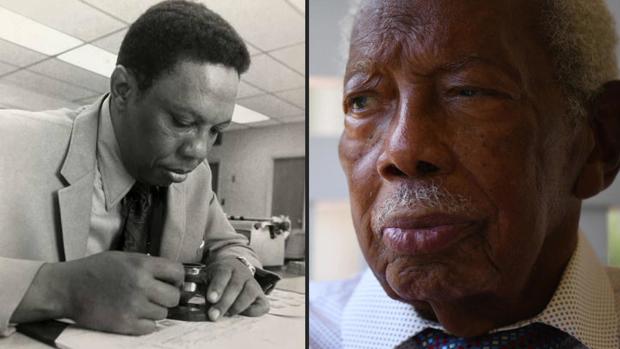 Sgt. Edgar Pickett was a legendary fingerprint expert with the Lakeland Police Department and led the crime scene unit when Linda Slaten was murdered. Sergeant Pickett recovered a palm print from the bedroom windowsill — a piece of evidence that would later play a crucial role in the investigation.
Sgt. Edgar Pickett was a legendary fingerprint expert with the Lakeland Police Department and led the crime scene unit when Linda Slaten was murdered. Sergeant Pickett recovered a palm print from the bedroom windowsill — a piece of evidence that would later play a crucial role in the investigation.
Edgar Pickett/CBS News
Jim Axelrod: What do you remember about the Slaten case?
Sgt. Edgar Pickett: I could remember everything about it. Goin’ to that window and lookin’ at it, where he went through it. … Then I went in there and the children was asleep. And I saw that coat hanger around her neck.
Former Sergeant Edgar Pickett, now 94 years old, was a legendary fingerprint expert with the Lakeland Police Department. He led the crime scene unit. In fact, the crime lab bears his name. But that sort of recognition was a long time coming.
Arriving at the Slaten crime scene in 1981, Pickett, then 53, was just a year away from retirement. But his hard-earned reputation had never spared him from prejudice.
Jim Axelrod: So, you pull up at the scene, and another detective says what to you?
Sgt. Edgar Pickett: That “A Black man don’t have any business lookin’ at a naked white woman.”
Jim Axelrod: Even though she was a homicide victim?
Sgt. Edgar Pickett: That’s correct.
Sergeant Pickett believed Linda Slaten had been strangled with a coat hanger from her own closet. He dusted most of the bedroom for fingerprints, even the floor.
Sgt. Edgar Pickett: And then I got that print off of that windowsill. … It was a palm print … it wasn’t a fingerprint.
Jim Axelrod: You got the most important print there is.
Sgt. Edgar Pickett: I know it.
The evidence Pickett uncovered would play a crucial role decades later — especially the palm print.
Sgt. Edgar Pickett: I had really had never seen anybody in the shape that that lady was in. And I’ve seen a lotta people killed.
An autopsy later confirmed what he already knew: Linda Slaten had been sexually assaulted and strangled to death. Swabs taken and preserved in a rape kit revealed semen. That morning, Pickett says, his thoughts kept returning to Linda Slaten’s boys.
Sgt. Edgar Pickett: I had children too. And I really wanted to clear that case. I did.
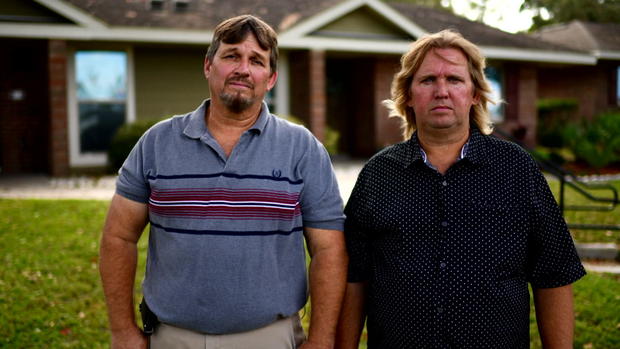 Jeff, left, and Tim Slaten stand outside their former home — in the spot they say their childhood ended on Sept. 4, 1981 As police hustled the boys outside, Tim says, “I saw the whole crime scene. … I saw my mom’s bloody body with a coat hanger around her neck … And I still see it.”
Jeff, left, and Tim Slaten stand outside their former home — in the spot they say their childhood ended on Sept. 4, 1981 As police hustled the boys outside, Tim says, “I saw the whole crime scene. … I saw my mom’s bloody body with a coat hanger around her neck … And I still see it.”
CBS News
Jim Axelrod: You guys are standing on the spot where your life changed.
Tim Slaten: Yes, right here.
Jeff Slaten: Yeah, when I stopped being a kid was right there (pointing).
Jim Axelrod: You were 15.
Jeff Slaten: 15.
Jim Axelrod: You really felt like this was the end of your childhood, right here?
Jeff Slaten: Yes, sir. I think this is exactly when it ended, when my Aunt Judy told me my mom had been murdered.
Emerging through the terror and tears that September morning 41 years ago, the questions kept coming. Why? Who? Who could have done such an evil thing?
SEPTEMBER 4, 1981 | HOURS AFTER THE MURDER
On that late-summer morning in 1981, Jeff and Tim Slaten faced a frightening world they no longer recognized, a world without their mother.
Jim Axelrod: How do 12 and 15-year-old boys process that, deal with that?
Tim Slaten: It was hard.
Jeff Slaten: Yeah. I thought about committin’ suicide a couple times (cries). It was that bad.
The brothers moved in with their grandparents, Clarence and Margaret Harris.
Tim Slaten: We just, we stayed in the house. We didn’t go anywhere.
Jeff Slaten: Scared to death.
Tim Slaten: Scared to death to do anything.
For those first terrifying days, the family slept in the same room — except Grandpa Harris.
Tim Slaten: He would stand guard with a gun all night while we slept.
The grandparents hoped a quick return to familiar routines would help their distraught grandsons. A few weeks after their mom’s funeral, the boys were back in school.
Tim Slaten: And just you know, being with friends and just — just started livin’ life again, I guess. … You know, goin’ back to football.
His teammates, and Coach Joe in particular, were always supportive, always rooting for him, says Tim.
Tim Slaten: And I looked up to this guy. He was my assistant football coach. … Give me rides to the games, rides to practice.
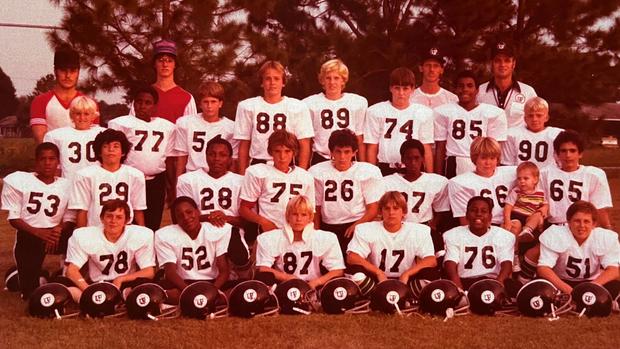 Tim Slaten’s football team photo was taken a month after Linda’s murder. Tim hung it on his bedroom wall as a reminder, he says, of something his mom taught him: to keep moving forward and never give up.
Tim Slaten’s football team photo was taken a month after Linda’s murder. Tim hung it on his bedroom wall as a reminder, he says, of something his mom taught him: to keep moving forward and never give up.
Tim Slaten
Tim’s team football photo hung in his bedroom. It was taken just one month after the murder. The picture was a reminder, he says, of something his mom had taught him: to keep moving forward and never give up.
Jim Axelrod: She was a fighter?
Tim Slaten: Yes. Oh, yes.
Jeff Slaten: She mighta only weighed 100 pounds soakin’ wet, but she was pretty tough.
Judy Butler: Everybody liked her that met her. Everybody was asking her for a date. … Cause she was so young and pretty.
And then Linda met and married Frank Slaten.
Judy Butler: He was a mean, no-count scoundrel.
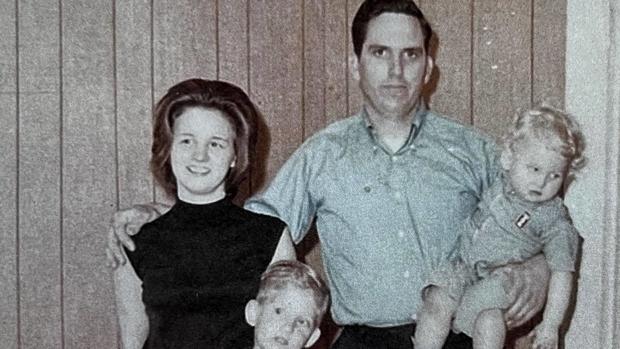 As detectives searched for the killer, Linda’s ex-husband, Frank Slaten, became a person of interest due to his history of abuse towards her. But investigators eventually seemed satisfied that Frank was home in Alabama on the night of the murder.
As detectives searched for the killer, Linda’s ex-husband, Frank Slaten, became a person of interest due to his history of abuse towards her. But investigators eventually seemed satisfied that Frank was home in Alabama on the night of the murder.
Jeff Slaten
The brothers say it’s hard to know when their dad began to beat their mom. The more he drank, the more violent he became.
Jeff Slaten: Yeah, I remember one time I was in the bathroom. He had her by the throat with a gun to her head and I was comin’ there tryin’ to get him off of her. … And I felt like I had saved her that, you know, that night. That day.
Jim Axelrod: But you were just a little guy yourself.
Jeff Slaten: Yeah, I was only … 6-and-a-half, 7 years old.
Frank Slaten’s history of abuse made him a person of interest for Lakeland detectives. But investigators seemed satisfied that Slaten was home in Alabama on the night of the murder. At the time of her death, Linda had a boyfriend. He, too, had a credible alibi. Others were looked at — like the partygoers next door — but no one was charged.
Jeff Slaten: The Lakeland Police Department … they used to come down to take me out of school and they was always interrogating me all the time.
Jim Axelrod: In the early days, it sounds like who the police really were most thorough in checking out —
Jeff Slaten (Jeff raises his hand): Was me.
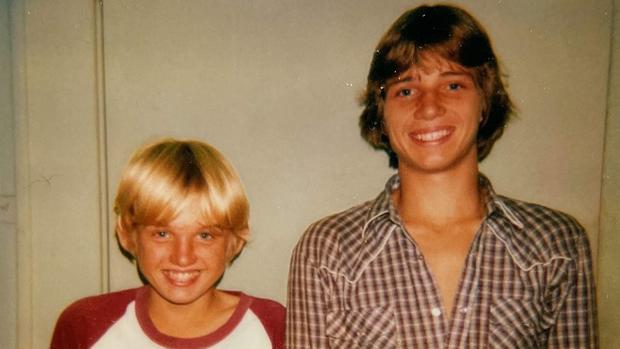 The Slaten brothers moved in with their grandparents and had to face a new reality of life without their mom. A few weeks after their mom’s funeral, the brothers returned to school and familiar activities.
The Slaten brothers moved in with their grandparents and had to face a new reality of life without their mom. A few weeks after their mom’s funeral, the brothers returned to school and familiar activities.
Jeff Slaten
As a 15-year-old, Jeff had plenty of typical teen conflicts with his mom, which he readily admitted to detectives — including that heated argument on the last day of her life.
Jeff Slaten: I know they had me, put me on a lie detector test one time. … And I passed it. Then they wanted to do it again. … They was wantin’ to put me under hypnosis.
Jeff Slaten: And then there’s one time, one of the cops … he’s, like … “You got big arms on you. And you’re strong enough to put your hands around your mom’s neck and kill her.”
Jeff Slaten: Wha…who would do that to a kid? I was a 15-year-old kid hurting, and say that to me? I mean, that’s— that’s always hurt.
Finally, Jeff’s grandparents said, “Enough.”
Jeff Slaten: They’s, like, “Get out there and find who killed my daughter. Leave this kid and leave this family alone.”
Two weeks later, according to the Lakeland Police report, Jeff took a second polygraph test and was cleared. At that point, the investigation slowed, then ground to a halt.
As the years passed, Jeff and Tim started their own families. But to this day, there is still grief and guilt for not hearing anything that night — for not coming to their mom’s rescue.
Jeff Slaten: I (would have) died that night tryin’ to save my mom. … I mean, we’re right there in the house. How could you not hear somethin’ like that?
And they lived in fear of the man they called, “The Monster.” Unless he was dead, he was out there … somewhere.
Around the 20th anniversary of their mom’s murder, Jeff and Tim met with Lakeland Detective Brad Grice, who was taking a fresh look at the case.
Det. Brad Grice: Soon as Jeff and Tim walked in the door, I realized I had known Jeff for years, since I was in my twenties … through bowling.
Jeff Slaten: I was, like, “Brad.” (laughs). … Sure enough, I knew him from bowlin’ years ago.
Grice took DNA samples from the brothers to clear them again, then gave Jeff something in return — a promise.
Det. Brad Grice: He made me promise that I wouldn’t retire until I solved his mother’s case. And I wanted to so bad for him and his brother. I did.
Grice had already sent DNA from the Slaten rape kit to the state’s major crime lab at the Florida Department of Law Enforcement — the FDLE.
Jim Axelrod: Do you have any confidence that you could solve it?
Det. Brad Grice: I was hopin’ DNA would, you know? It was becomin’ a big tool.
By March 1999, the FDLE had developed a full DNA profile of Linda Slaten’s anonymous killer.
Jim Axelrod: All you need is a DNA match.
Det. Brad Grice: A hit. … That’s all I needed was a hit in the database.
Detective Grice took dozens of DNA samples from prior persons of interest, submitting them to the FDLE for comparison.
Det. Brad Grice: We were tryin’ everything.
Even the brothers’ father, Frank Slaten — who had stopped drinking — volunteered a sample. None matched.
Then in September 2001, Grice got a tip. Nearly a year after the Slaten killing, a 24-year-old man named Jimmy Ulmer pulled a 10-year-old girl through her bedroom window and nearly killed her.
Det. Brad Grice: He was convicted of that and sentenced to, like, 80 years in prison.
The savage assault seemed eerily similar to the Slaten case. And Detective Grice discovered that, around the time of Linda’s Slaten’s murder, Jimmy Ulmer had been staying with a friend who happened to live in the very same apartment complex as Slaten.
Jim Axelrod: Hang on. Jimmy Ulmer … was staying in an apartment right across the way from the Slatens?
Det. Brad Grice: Yes.
Jim Axelrod: You must’ve felt like that’s our guy.
Det. Brad Grice: I felt very strong. I did.
Ulmer had died in prison five years earlier in 1996. But Grice got a DNA sample from his mother.
Det. Brad Grice: I honestly felt that when we got the results back that we would know who did it. Then we get the notice that it wasn’t him.
Jim Axelrod: At that point, you must’ve been, like, “We’re never gonna solve this thing.”
Det. Brad Grice: It sure felt that way. It was very discouraging.
Jeff Slaten: You know it’s like, “Oh my God, we’re back to square one again.”
Tim Slaten: It felt like you was on a rollercoaster for pretty much your whole life.

Linda Slaten’s sons: “We wanna know who killed our mom”
28 photos
By 2005, 24 years after the murder, Detective Grice was heading up a new cold case unit. And the FBI was running the DNA profile of Slaten’s killer continuously through all federal databanks. But the years continued to pass without a match.
Det. Brad Grice: Jeff would call. And “Jeff, I — I got nothin’ for ya,” you know? … It hurt my heart too, you know?
Grice had a growing suspicion he was chasing a ghost.
Det. Brad Grice: I honestly thought the suspect might be deceased.
He had made that promise to the brothers that he wouldn’t retire until their monster was caught.
Det. Brad Grice: I had some medical things that were poppin’ up.
It was a promise he couldn’t keep. Detective Grice retired in 2015.
Jim Axelrod: There was probably nothing in your professional life you wanted more than to call Jeff Slaten and say, “Got him.”
Det. Brad Grice: Absolutely.
Jeff Slaten: After Detective Brad Grice retired, I’m like, I said, “Well, I’ll probably take my last breath and not know who murdered my mom.” I was already starting to come to terms with it.
But three years later, there was renewed hope. A groundbreaking DNA technology began to electrify the law enforcement community. And Genetic Genealogist CeCe Moore was taking on the Slaten case.
CeCe Moore: I was determined I was going to help these boys find out who killed their mom.
JUNE 2019 | 38 YEARS AFTER THE MURDER
CeCe Moore is a renowned expert in the field of investigative genetic genealogy.
CeCe Moore: If you have that DNA there is no reason you cannot solve that mystery, whatever that mystery is.
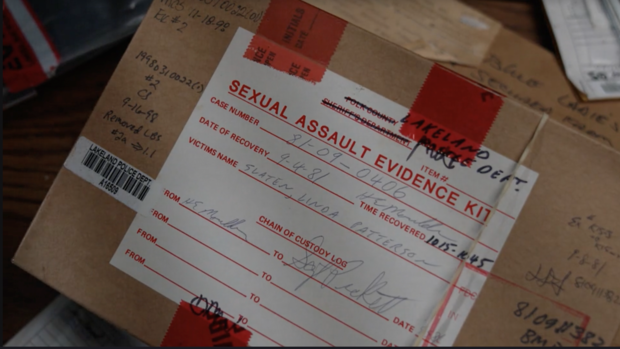 During her autopsy, swabs were collected from Linda Slaten that contained semen. Investigators carefully preserved the contents of the rape kit for years to come. Forensic DNA analysis didn’t exist until 1984. Later, it would prove key to solving this case.
During her autopsy, swabs were collected from Linda Slaten that contained semen. Investigators carefully preserved the contents of the rape kit for years to come. Forensic DNA analysis didn’t exist until 1984. Later, it would prove key to solving this case.
Lakeland Police Department
Moore launched her hunt for Linda Slaten’s killer by uploading the anonymous DNA from Slaten’s rape kit to a public genealogy website called GEDMatch. She then meticulously constructed — branch by branch — his genetic family tree.
CeCe Moore: I built the family trees of those people who shared DNA with him. And then I identify common ancestors between those people.
She made those connections by poring over birth certificates, marriage licenses, obituaries and social media to fill in the family tree with names.
Jim Axelrod: It sounds like basically you’re putting together a giant jigsaw puzzle.
CeCe Moore: Yes. My work is constantly putting together puzzles. Piece by piece by piece.
CeCe Moore (referring to section of family tree): These matches all share DNA with each other. So, they’re my first genetic network.
CeCe Moore uncovered three genetic networks — branches of the killer’s family tree that ultimately narrowed to the one person most likely responsible for the murder of Linda Slaten.
CeCe Moore: Fortunately, those three genetic networks converged into one family tree that pointed at one immediate family. And he was the only son in that family. And we knew the killer was a male. So, it had to be him that was the DNA contributor.
After hundreds of leads and dead ends, after dozens of suspects were investigated and cleared, CeCe Moore identified the probable killer in one weekend.
CeCe Moore: There was just one person who was high confidence.
Jim Axelrod: And who was that?
CeCe Moore: Joseph Clinton Mills.
Joseph Clinton Mills — Coach Joe — who drove Linda Slaten’s 12-year-old son, Tim, to and from practice. But authorities wanted to be certain before they notified the brothers.
CeCe Moore: And then there is sort of exhilaration because he’s alive. … And so there’s a real chance for justice and maybe even answers.
CeCe Moore’s final 2019 report confirmed that Joseph Mills, then 58, was living in Kathleen, Florida, about half an hour from the crime scene.
Det. Tammy Hathcock: I reviewed the case, and … I’m like, “I remember that name.” … I remember seeing that name. That — that guy was interviewed.”
Detectives Tammy Hathcock and Russell Hurley were the next generation of Lakeland investigators leading the Slaten cold case.
Det. Tammy Hathcock: I’m telling you, it’s like I won the lottery. I remember grabbing that piece of paper from the report and just running down the hallway to my sergeant saying, “Oh, my God he was interviewed! He was interviewed!”
According to the case file, investigators did question Joseph Mills, then 20 years old, just one day after the murder.
Det. Tammy Hathcock: He was very basically touched. I mean like just a very brief interview.
And it was conducted on the phone, not in person.
The fact that investigators never questioned Mills face to face suggests he was never considered a suspect. During the brief call, Mills acknowledged he had driven Tim Slaten home from football practice on September 3. Just hours later, Linda Slaten was dead.
Jim Axelrod: How was Joseph Mills not followed up on more aggressively in 1981?
Det. Tammy Hathcock: At that point, I mean he was just a football coach that had dropped off Timmy. … He was never on their radar to … be a suspect just based off of the information that they were given by Timmy and by Mr. Mills.
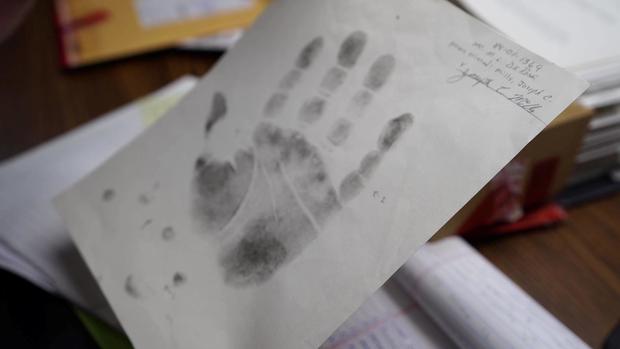 In 2019, investigators compared Joseph Mills’ palm print from a 1984 conviction for grand theft for forging a will to the palm print that was lifted off Linda Slaten’s windowsill in 1981 and they were a match.
In 2019, investigators compared Joseph Mills’ palm print from a 1984 conviction for grand theft for forging a will to the palm print that was lifted off Linda Slaten’s windowsill in 1981 and they were a match.
Lakeland Police Department
Joseph Mills was convicted in 1984 of grand theft for forging a will. He never went to jail, but he was fingerprinted. Lakeland police also took a palm print. In August 2019, investigators compared those prints to the palm print Sergeant Pickett lifted off Slaten’s windowsill nearly 38 years before.
Jim Axelrod: When the prints came back, there was a match?
Det. Russell Hurley: Yes.
High-tech genetic genealogy had identified Mills as the likely killer, and an old-fashioned palm print match helped confirm his identity. But Hathcock and Hurley still needed to compare a fresh DNA sample from Mills to the decades-old DNA recovered from the crime scene.
Det. Russell Hurley: ‘Cause we had to get his DNA without his knowledge and see if we can get a match. …We had to do some surveillance.
Det. Tammy Hathcock: It was several weekends that we were following him around …
Det. Tammy Hathcock: … trying to get discarded DNA.
Jim Axelrod: Just looking for a cup that he drank from or a tissue that he used.
Det. Tammy Hathcock: Anything.
After tracking Mills with no luck, the detectives decided it was time to get their hands dirty. They covertly took Mills’ trash back to the police department
Det. Tammy Hathcock: Here we are in dress clothes just digging through trash bags. … Not the most glamorous thing.
They discovered a piece of used medical adhesive tape and sent it off to the FDLE crime lab for testing. After searching Mills’ trash, they dug through his life.
Det. Tammy Hathcock: He’s been married to the same woman. And he lived in the same place.
Det. Russell Hurley: He was a business owner … a cleaning service.
Det. Tammy Hathcock: …he was a truck driver over the years.
Det. Tammy Hathcock: He had a family.
Jim Axelrod: Married, kids
Det. Tammy Hathcock: Married, kids, grandkids.
Eleven days later, the stunning lab results: Joseph Mills’ 2019 DNA found on the medical tape and the 1981 unknown DNA from Linda Slaten’s rape kit were a spot-on match. That’s when the brothers were told the monster had been found.
Jim Axelrod: This guy you last knew as Coach Joe, oh my goodness, it was him.
Tim Slaten: And I had a picture in my house ever since then, and never knew it was him.
 “I looked up to this guy,” says Tim Slaten, pictured with “Coach Joe” Mills. “And I had a picture in my house ever since then, and never knew it was him.”
“I looked up to this guy,” says Tim Slaten, pictured with “Coach Joe” Mills. “And I had a picture in my house ever since then, and never knew it was him.”
Tim Slaten
Tim’s 1981 team football photo, a source of pride for years, sickens him today. Because standing directly behind him is the man he once trusted and admired. Coach Joe.
Tim Slaten: I’ve been carrying the killer’s picture in my house this whole time and never had a clue.
Even after the murder, Joseph Mills continued driving Tim to and from football practice — picking him up and dropping him off at his grandparents’ house.
Tim Slaten: He’d ask us how the case was goin’. … He wouldn’t ask questions about it. He just, “Well, any new news or any new leads?” And I was, like, “No, nothing.” You know.
Jim Axelrod: He’s talkin’ to a 12-year-old boy and tryin’ to keep tabs on a murder investigation through the son of the murdered woman?
Jeff Slaten: Yeah.
Tim Slaten: Yes.
Jim Axelrod: When he knows exactly who did it.
Jeff Slaten: He’s a cold-hearted monster, that’s for sure.
On Dec 12, 2019, the detectives moved in, arresting Joseph Mills.
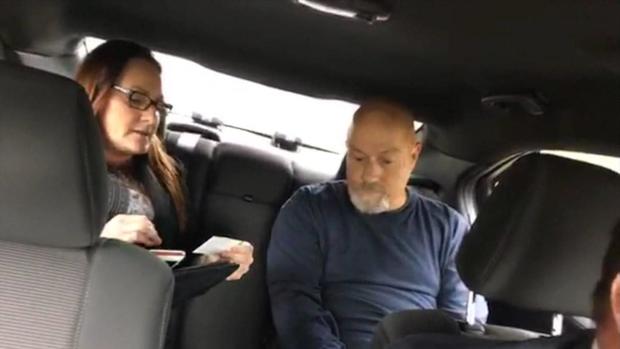 Detective Tammy Hathcock reads Joseph Clinton Mills his rights in the back of a police car 38 years after Linda Slaten’s murder.
Detective Tammy Hathcock reads Joseph Clinton Mills his rights in the back of a police car 38 years after Linda Slaten’s murder.
Lakeland Police Department
DET. TAMMY HATHCOCK (sitting next to Mills in backseat of police car): You have the right to remain silent. Anything you say can be used against you in a court of law …
Det. Russell Hurley: He was calm, cool, and collected like it was another day on the beach. … Most people’s reaction would be, “Why am I bein’ arrested?”
Jim Axelrod: “Why are you takin’ me in?” You expected some of that?
Det. Tammy Hathcock: Right, some kind of emotion, and nothing.
DECEMBER 2019 | 38 YEARS AFTER THE MURDER
DET. RUSSELL HURLEY (police interview): It’s been 38 years, and I’m sure you go to bed every night thinking about this. I have no doubt in my mind.
Detectives Hathcock and Hurley finally had Joseph Mills right where they wanted him — in the claustrophobic confines of a police interview room.
JOSEPH MILLS (police interview): When I picked the boys up, we — we — we stayed in the vehicle. And I don’t recall going to, in or out of the house, period.
Det. Tammy Hathcock: There’s no way that is the truth. I mean, he’s saying he’s never been in there. … We got him.
DET. TAMMY HATHCOCK (police interview): What we have tells us a different story. OK. You were in that apartment.
Ratcheting up the pressure, the detectives told Mills they had overwhelming evidence placing him inside Linda Slaten’s bedroom.
DET. TAMMY HATHCOCK (police interview): Your fingerprints matches you, the DNA matches you.
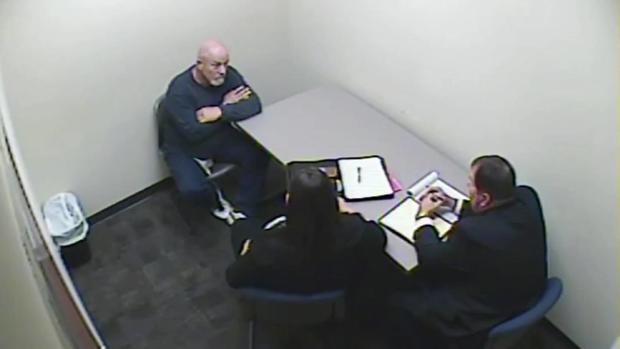 During his interrogation, Mills told detectives that Linda Slaten invited him over for consensual sex, which investigators knew was a lie. “I think it’s pretty evident that he targeted her,” Det. Russell Hurley says.
During his interrogation, Mills told detectives that Linda Slaten invited him over for consensual sex, which investigators knew was a lie. “I think it’s pretty evident that he targeted her,” Det. Russell Hurley says.
Lakeland Police Department
That’s when Mills’ story began to change.
DET. RUSSELL HURLEY: And then how did you end up crawling through her window?
JOSEPH MILLS: It was like an invitation.
An invitation from Linda Slaten, Mills claimed, for consensual sex — a flat-out lie, say the detectives.
Det. Russell Hurley: He said it was a sex game, that she had the hanger around her neck when he came through the window and she asked him to tighten it down.
DET. RUSSELL HURLEY: And then did you … start applying pressure?
JOSEPH MILLS: Yes.
Det. Russell Hurley: And when I pointed out well the brutality of the hanger and how deep it was into her skin he stuck with the “It was a game.”
DET. RUSSELL HURLEY (to Mills): You purposely killed her. We’re all sittin’ here, we know that.
Jim Axelrod: At the end of the day what happened here?
Det. Russell Hurley: I think it’s pretty evident that he targeted her.
After dropping off Tim from football practice on Sept. 3, 1981, Joseph Mills returned later that night, the detectives say, breaking in through Linda Slaten’s bedroom window. No one heard Mills, they believe, because no one was home. Jeff was still at his grandparents’ house; Linda and Tim were at the party next door.
Det. Russell Hurley: If you look at the crime scene and all that — the hanger obviously came from the closet. … We figured that’s what happened … is he was hiding in the closet.
DET. RUSSELL HURLEY: Were you ever in the closet?
JOSEPH MILLS (long pause): No sir.
In the final moments of her life, the detectives believe that Linda, after saying goodnight to her sons, walked into her bedroom and closed the door — never knowing that Mills was already inside waiting for her. There was no invitation, no consensual sex, they say. Joseph Mills raped and murdered Linda Slaten.
Detective Brad Grice always suspected the killer’s name was buried somewhere in the thick police case file.
Jim Axelrod: Why do you feel that the investigation didn’t circle back to Joseph Mills?
Det. Brad Grice: Well, obviously, I put a lotta that on me now.
Jim Axelrod: You do?
Det. Brad Grice: I do.
 After dropping off Tim from football practice on Sept. 3, 1981, Joseph Mills returned later that night, the detectives say, breaking in through Linda Slaten’s bedroom window. No one heard Mills, they believe, because no one was home.
After dropping off Tim from football practice on Sept. 3, 1981, Joseph Mills returned later that night, the detectives say, breaking in through Linda Slaten’s bedroom window. No one heard Mills, they believe, because no one was home.
Lakeland Police Department
Grice blames himself for not taking a harder look at Joseph Mills — a sentiment not shared by the Slaten brothers. They feel nothing but gratitude to the detective and friend who spent 17 years chasing the elusive killer.
Jeff Slaten: I could tell how — how hard he wanted to solve it.
Jeff Slaten: And I actually named my son after him. My son’s named Brad, too.
Det. Brad Grice: Jeff put a little pressure on me over the years, you know, he did. You can’t retire until you solve this case, and then he named his son after me.
Det. Brad Grice: And honestly, I just wanted to solve this case for them more than anything.
So did this former investigator — 94-year-old Edgar Pickett. The brothers had always wanted to meet him.
Jeff Slaten: So, I wanna thank you for all you did for our mama back then. … If you hadn’t of done it, this monster would still be running free today.
Sgt. Edgar Pickett: Sure would, huh?
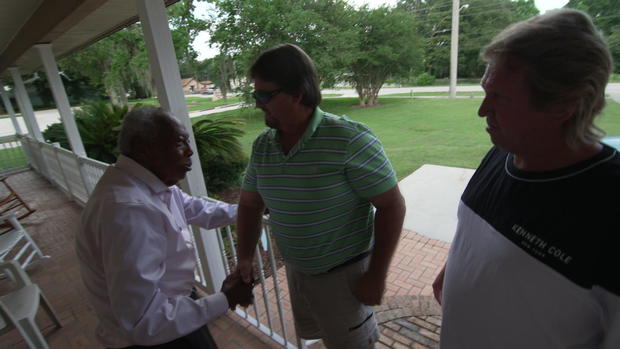 Jeff and Tim Slaten meet Sgt. Pickett for the first time, thanking him for his role in solving their mother’s murder.
Jeff and Tim Slaten meet Sgt. Pickett for the first time, thanking him for his role in solving their mother’s murder.
CBS News
It is poignant praise for Sergeant Pickett, who lifted the palm print that helped identify the monster, Joseph Mills.
Sgt. Edgar Pickett: That’s the case I can never forget.
Sgt. Edgar Pickett (pointing to his head): It’s up here, I can’t get rid of it.
During his distinguished and trailblazing 29-year career, Sergeant Pickett had seen it all. And yet, it’s the Linda Slaten case that haunts him to this day. He never knew police had questioned a man named Joseph Mills just one day after the killing.
Jim Axelrod: You didn’t know for 38 years that he was talked to immediately afterward?
Sgt. Edgar Pickett: No, I didn’t.
Instead, Pickett says he was asked to compare prints of a number of black men who were questioned in the days after the murder following neighbors’ reports of suspicious activity.
Sgt. Edgar Pickett: They kept pickin’ up a lotta Blacks. And they was given me their prints for me to look at theirs.
It not just haunts, but angers Pickett: Black men were rounded up and fingerprinted, while the White football coach — driving Linda’s son to and from practice — was never considered a suspect.
Sgt. Edgar Pickett: They just talked to him and let him go.
Jim Axelrod: You’re telling me this case … could’ve been solved in the first days after the murder…if they had just taken a print from Joseph Mills?
Sgt. Edgar Pickett: That’s correct.
Jim Axelrod: There’s a lot of people who came before you. I get it. … But you got a palm print in the windowsill almost immediately. … Wouldn’t you just get some prints from the guy, anybody who had been near the house in the 24 hours prior to the murder?
Det. Russell Hurley: There was no indication that he had been in the house. I mean, all the witnesses said that he dropped the kid off from practice and never got out of the truck, so … The only reason why he was spoke to was because, when they backtrack on the previous 24 hours, he was in that equation
Jim Axelrod: You don’t feel like he slipped through the net?
Det. Tammy Hathcock: No.
Det. Russell Hurley: No.
Joseph Mills’ day of reckoning would finally come 40 years later.
Jeff Slaten: He’s got cold, black, murderin’ eyes, this Joseph Clinton Mills. He just sit there. … Not a word…
FEBRUARY 9, 2022 | 41 YEARS AFTER THE MURDER
Tim Slaten: Our mom was a good person. He took that away from us.
To avoid a trial and a possible death sentence, Joseph Mills pleaded guilty to all charges — including first-degree murder, sexual battery and burglary. At his sentencing, what Linda Slaten’s family wanted most was the answer to one question.
JEFF SLATEN (yelling at Mills in court): Why? I just want to know why, Joe? Why’d you take my mama from me? I loved my mama. We was happy.
Tim Slaten: My blood would start boilin’ every time I look at him.
The brothers, and Aunt Judy, tried to look him in the eye.
Judy Butler: To see if there was any human being in there, to see if he was alive, to see if he had a soul. Never saw it.
His silence infuriated the family. And a few minutes later, so did his comments to the court.
JOSEPH MILLS (in court): I am a good person. I’m not that person that they’re painting me out to be …
CeCe Moore: I think this case made me the angriest out of the hundreds of cases I’ve been involved in because what he did with her children there. … And then the things he said about her.
Jim Axelrod: That she lured him in.
CeCe Moore: Even all these years later he was willing to try to make her look bad, to denigrate the victim, and her boys have to hear that. It’s just sickening.
JUDGE: I will sentence you to life in prison without the possibility of parole …
And just like that, Joseph Clinton Mills was gone — facing four life terms and finally, a measure of justice.
Jim Axelrod: Maybe not full justice in your view.
Tim Slaten: It’s not full justice, by no means.
Tim Slaten: I wanted him to go to trial. … I wanted to see him up on the stand and tell everybody why he did this, and he never did that.
The Slaten brothers feel some comfort knowing Joseph Mills will never leave prison alive. But there’s still anger, they say, because Mills never took full responsibility for the premeditated rape and murder of their mother. He never apologized. And there were all those years of freedom.
Tim Slaten: He lived his whole life. He raised his family. You know, he had a good life.
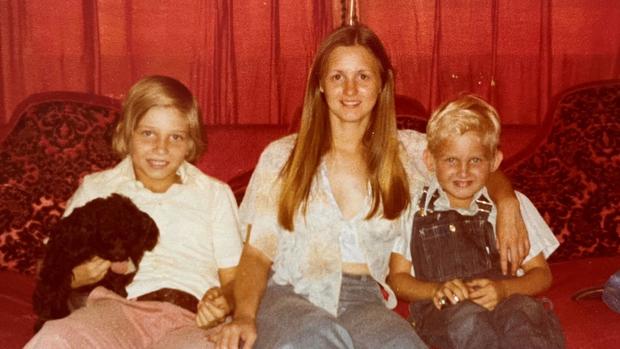 “Loved ones, and especially children of a murder victim, they need those answers,” says genetic genealogist CeCe Moore. “The best outcome is that they get justice.”
“Loved ones, and especially children of a murder victim, they need those answers,” says genetic genealogist CeCe Moore. “The best outcome is that they get justice.”
Jeff Slaten
It’s the brothers who feel they were handed the far more severe sentence: life without the possibility of growing up with their mom.
Jeff Slaten: She’d still be here today. She’d only be 72, you know? Coulda had her my whole life.
Jeff Slaten: I just wonder what life could have been like to have her.
Jim Axelrod: Any part of you when you think about all of this … at all angry with the way the police handled it, that it took this long to get Joseph Mills?
Tim Slaten: You could look at it that way. I know it’s a lotta hard work behind the scenes that people don’t see that goes on. You know, what they do, the hours upon hours they put in. I mean, you could get mad, but only so much could be done in a day.
CeCe Moore: We owe a huge debt of gratitude to those original crime scene investigators. Because at the time this crime was committed, they didn’t even know DNA was going to be used in criminal investigations. … And so the fact they collected that and then it was stored responsibly and carefully all these years by that department is so important. If that hadn’t happened, we couldn’t have done our work.
Jeff and Tim say they’re determined to move on as best they can, to live life well for their mom and for their families.
The brothers also know they never would have survived their ordeal without each other. They remain extremely close, live just a few miles apart, and share passionate hobbies, like restoring cars.
Jim Axelrod: You give the credit for living this life to the spirit of your mom?
Tim Slaten: Yes.
Jeff Slaten: Most definitely.
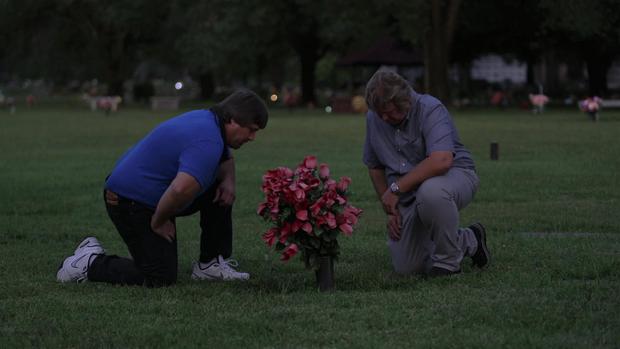 “Sure do love you, Mom. I miss you so much every day,” say Jeff Slaten with his brother Tim at their mother’s gravesite.
“Sure do love you, Mom. I miss you so much every day,” say Jeff Slaten with his brother Tim at their mother’s gravesite.
CBS News
Jeff Slaten: My mom, she’s looking down on us and would want us to live our lives and do good. You know. … And I always think she’s looking down on us. I want to make her proud.
Tim Slaten: Yes.
Jeff Slaten: Want to make her proud.
Tim Slaten: Yes.
The Slaten brothers visit their mother’s grave together often.
Jeff burns a candle next to a portrait of his mother every year on the anniversary of her death.
Produced by Mead Stone. Gabriella Demirdjian is the field producer. Marc Goldbaum and Sara Ely Hulse are the development producers. Nancy Bautista is the broadcast associate. Mead Stone, Greg Kaplan and Grayce Arlotta-Berner are the editors. Peter Schweitzer is the senior producer. Nancy Kramer is the executive story editor. Judy Tygard is the executive producer.







